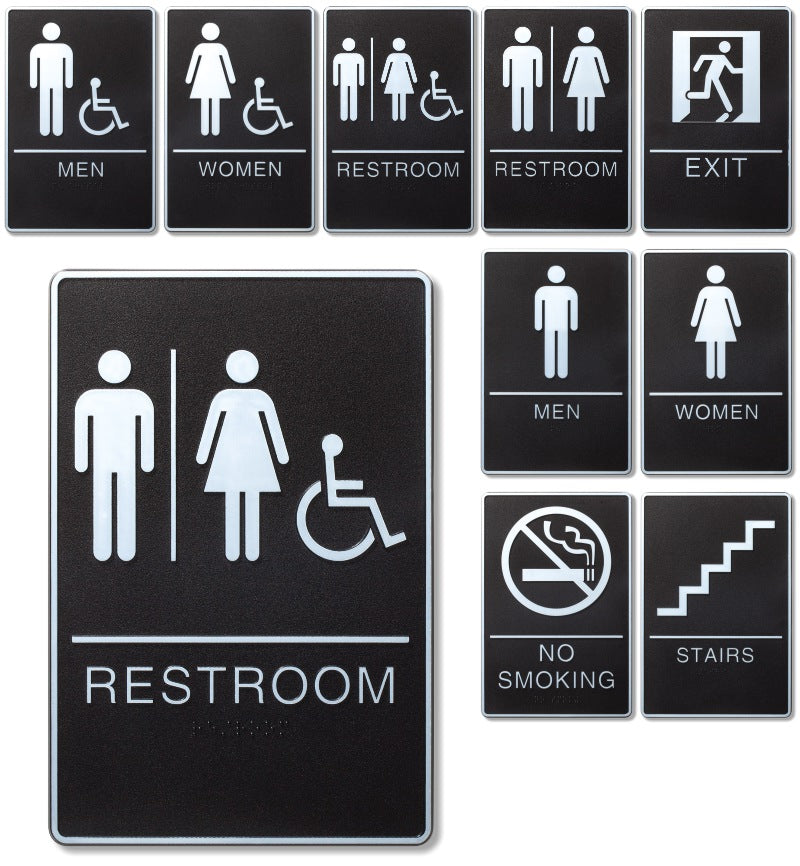Check out the Significance of ADA Signs in Public Spaces
Wiki Article
Checking Out the Trick Attributes of ADA Indications for Boosted Ease Of Access
In the world of ease of access, ADA indicators serve as silent yet effective allies, guaranteeing that rooms are accessible and comprehensive for individuals with handicaps. By integrating Braille and responsive components, these signs break barriers for the visually damaged, while high-contrast color schemes and clear font styles provide to varied visual requirements.Importance of ADA Conformity
Ensuring conformity with the Americans with Disabilities Act (ADA) is important for cultivating inclusivity and equivalent accessibility in public rooms and work environments. The ADA, established in 1990, mandates that all public facilities, companies, and transportation solutions fit people with specials needs, ensuring they delight in the exact same civil liberties and possibilities as others. Conformity with ADA criteria not just fulfills lawful obligations but likewise improves a company's track record by demonstrating its commitment to variety and inclusivity.Among the vital facets of ADA conformity is the execution of obtainable signage. ADA indicators are made to guarantee that people with specials needs can conveniently browse via rooms and buildings. These signs have to abide by certain guidelines pertaining to dimension, font, shade comparison, and positioning to guarantee visibility and readability for all. Correctly carried out ADA signs aids eliminate barriers that people with disabilities often run into, thus promoting their freedom and confidence (ADA Signs).
Additionally, adhering to ADA guidelines can reduce the threat of prospective fines and lawful effects. Organizations that stop working to abide by ADA guidelines may face claims or penalties, which can be both monetarily difficult and damaging to their public image. Hence, ADA compliance is indispensable to fostering an equitable environment for everybody.
Braille and Tactile Elements
The consolidation of Braille and responsive aspects into ADA signs personifies the concepts of accessibility and inclusivity. These attributes are vital for individuals that are aesthetically damaged or blind, enabling them to browse public spaces with higher freedom and confidence. Braille, a responsive writing system, is necessary in providing composed info in a layout that can be easily regarded through touch. It is normally positioned below the matching message on signage to make sure that people can access the details without visual assistance.Tactile elements expand beyond Braille and consist of elevated personalities and symbols. These components are designed to be noticeable by touch, allowing individuals to determine room numbers, restrooms, leaves, and other vital locations. The ADA sets particular standards concerning the dimension, spacing, and positioning of these responsive elements to optimize readability and guarantee consistency across different atmospheres.

High-Contrast Color Systems
High-contrast color design play a critical duty in improving the exposure and readability of ADA signage for people with aesthetic impairments. These systems are essential as they make best use of the distinction in light reflectance between text and background, making certain that indicators are conveniently noticeable, even from a range. The Americans with Disabilities Act (ADA) mandates the usage of details shade contrasts to fit those with limited vision, making it a vital element of conformity.The efficacy of high-contrast colors depends on their capability to stand apart in different illumination conditions, consisting of dimly lit atmospheres and locations with glow. Typically, dark message on a light history or light text on a dark history is utilized to attain optimal contrast. For instance, black message on a white or yellow background gives a raw visual difference that helps in quick acknowledgment and understanding.

Legible Fonts and Text Size
When taking into consideration the style of ADA signs, the selection of readable typefaces and proper message dimension can not be overemphasized. web link These components are critical for making sure that indicators come to people with aesthetic impairments. The Americans with Disabilities Act (ADA) mandates that font styles need to be not italic and sans-serif, oblique, script, highly ornamental, or of uncommon type. These needs aid ensure that the message is quickly legible from a range which the characters are distinct to diverse audiences.The dimension of the text likewise plays an essential role in accessibility. According to ADA guidelines, the minimal text height need to be 5/8 inch, and it must increase proportionally with viewing distance. This is specifically essential in public areas where signage needs to be checked out promptly and properly. Consistency in message dimension adds to a cohesive visual experience, aiding individuals in navigating atmospheres effectively.
Additionally, spacing in between letters and lines is important to clarity. Ample spacing stops characters from appearing crowded, boosting readability. By sticking to these requirements, developers can substantially improve access, guaranteeing that signage serves its intended function for all people, regardless of their aesthetic abilities.
Effective Positioning Strategies
Strategic placement of ADA signs is important for optimizing availability and making certain compliance with legal requirements. Correctly located indications lead people with handicaps properly, assisting in navigating in public spaces. Secret considerations consist of closeness, height, and visibility. ADA guidelines specify that signs should be mounted at a height between 48 to 60 inches from the ground to ensure they are within the line of view for both standing and seated people. This standard height range is crucial for inclusivity, allowing mobility device users and individuals of varying heights to access details effortlessly.In addition, indications need to be positioned nearby to the lock side of doors to enable easy recognition before access. Consistency in indicator positioning throughout a facility boosts predictability, minimizing confusion and enhancing overall customer experience.
Conclusion
ADA indications play an important function in promoting availability by incorporating attributes that resolve the demands of people with handicaps. These components collectively promote a comprehensive environment, underscoring the importance of ADA conformity in making sure equivalent gain access to for all.In the realm of ease of access, ADA signs serve as quiet yet effective allies, making certain that rooms are accessible and inclusive for people with specials needs. The see this website ADA, passed in my blog 1990, mandates that all public facilities, companies, and transport services suit individuals with specials needs, guaranteeing they delight in the same civil liberties and possibilities as others. ADA Signs. ADA indications are made to ensure that people with impairments can easily browse with buildings and rooms. ADA standards state that signs must be mounted at an elevation in between 48 to 60 inches from the ground to ensure they are within the line of view for both standing and seated individuals.ADA indicators play an important duty in advertising availability by integrating functions that address the demands of individuals with handicaps
Report this wiki page